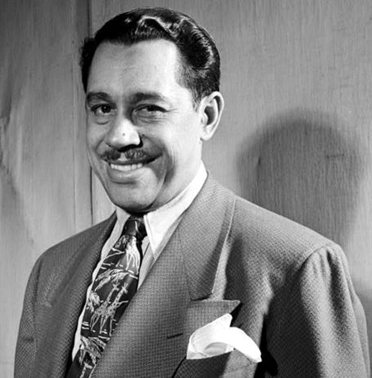Cab Calloway (1907-1994), was an American singer, composer, and bandleader. Calloway was the son of a middle-class Rochester family. He lived in New York until 1918. Later, he lived in Baltimore. Cabell Calloway II was his father and Martha Eulalia Reed was his mother. They were both lawyers. His parents recognized his musical talent and he started private voice lessons in 1922. He continued to learn music and voice through his formal education. Despite the disapproval of his parents and vocal teachers, Calloway started to frequent and eventually perform in Baltimore’s jazz clubs. He was mentored by Chick Webb, a drummer, and Johnny Jones, a pianist. After graduating high school, Calloway joined Blanche in a touring production Plantation Days, a popular black musical revue. Blanche Calloway went on to be an accomplished bandleader, and he often credits her with his decision to go into show business. Calloway was a student at Lincoln University in Pennsylvania. He left the university in 1930. Cab decided to stay in Chicago with his sister, a jazz singer, after the tour had ended in Chicago. His parents hoped that their son would become a lawyer like their father so Calloway was enrolled at Crane College. He was primarily interested in singing and entertaining. He spent his nights at the Dreamland Cafe and Sunset Cafe as a singer, emcee, and drummer. He met Louis Armstrong at the Sunset Cafe and learned how to sing the scat. TheCotton club was the most prestigious jazz venue in America, and Cab Calloway’s Orchestra (he had previously taken over “The Missourians”, a great but failing band in 1930) were hired to replace the Duke Ellington Orchestra. His band quickly became the co-house band for Ellington’s and Calloway and his group began traveling the country when they weren’t at the Cotton Club. The Cotton Club’s twice weekly live radio broadcasts on NBC helped to increase their popularity. Calloway was also featured on Walter Winchell’s radio program, and in the Paramount Theatre show with Bing Crosby. These appearances led to Calloway and Ellington breaking the major broadcast network colour barrier. Calloway’s provided ample soloing space for its members unlike other bands with similar commercial success and, through the diverse arrangements of Walter “Foots” Thomas, offered more musical interest. He recorded “Minnie the Moocher”, his most well-known song in 1931. This song was performed in the Betty Boop animated shorts Minnie the Moocher and Snow White. Cab was able to add his voice and dance moves through rotoscoping. Cab used this opportunity to time his concerts in certain communities with the film’s release in order make the most of the attention. He was instantly associated with the chorus of “Minnie the Moocher”, earning the nickname “The Hi De Ho Man” as a result. In the 1930s, he also appeared in a number of Paramount short films. Ellington and Calloway were the most prominent Jazz Orchestras of that era. He was featured in Stormy Weather, a high-profile musical film by 20th Century Fox. He was a well-known actor and singer in his later years. He played the role of Sportin’ life in the 1952 Gershwin opera Porgy and Bess. Another role he played was Yeller, in The Cincinnati Kid (1965). Calloway starred in 1967’s revival of Hello, Dolly! as Horace Vandergelder. Even though the original production was still in operation, Calloway starred as Horace Vandergelder. This production was a huge success and led to RCA releasing a cast recording. He was also featured in a failed Broadway revival of The Pajama Game from 1973-1974. In 1980, Calloway was a supporting role in the film The Blues Brothers. He performed “Minnie the Moocher” and again on Sesame Street when he sang “The Jumpin’ Jive”. The cult movie Forbidden Zone, featuring parodies and rearrangements of Cab Calloway songs, was released in this year. Six months prior to his death, Calloway suffered a stroke and died on 18 November 1994. The Cab Calloway Orchestra, which was directed by Cab’s great-grandson C. “CB”, Calloway Brooks, was established in 1998 to honor Cab Calloway’s legacy both nationally and internationally. Text contributed by users is available under Creative Commons By–SA License. It may also be available under GNU FDL.
